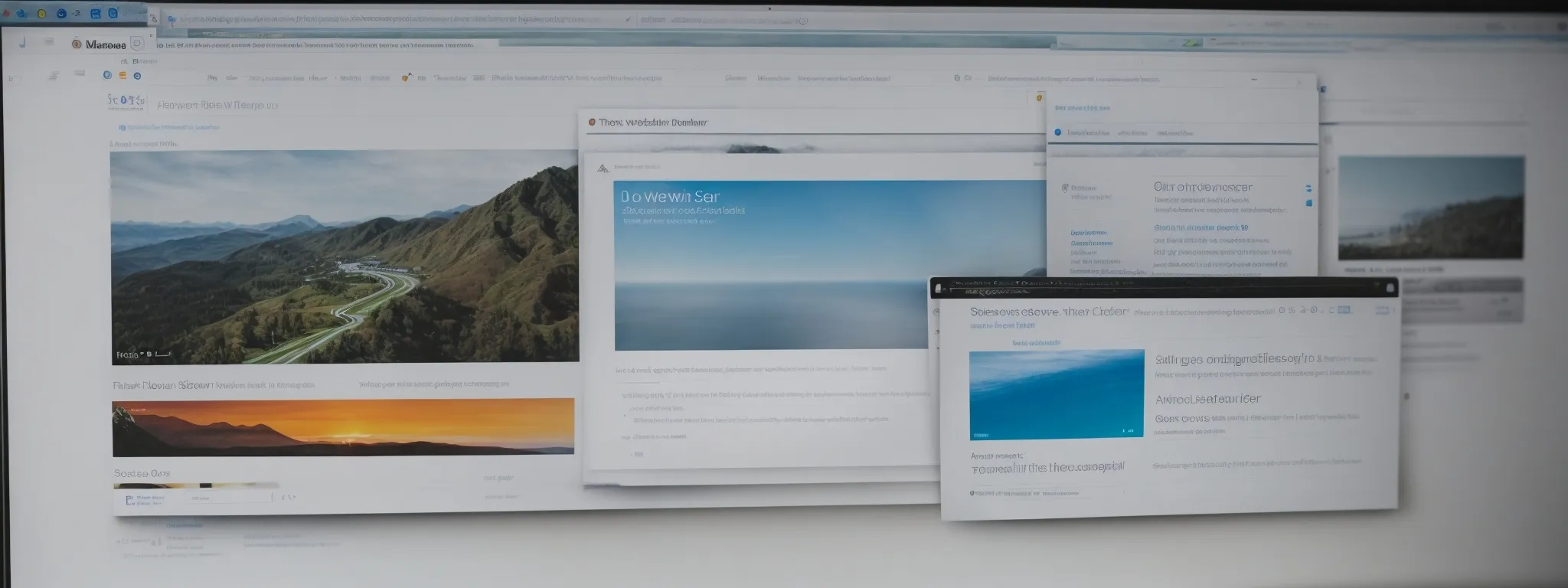www vs Non-www SEO
Understanding WWW vs Non-WWW for SEO: Which Is Better for Your Site? The decision between a WWW or non-WWW domain often sparks a debate among website owners, […]
Understanding WWW vs Non-WWW for SEO: Which Is Better for Your Site?
The decision between a WWW or non-WWW domain often sparks a debate among website owners, web developers, and SEO professionals, each combatting an array of myths and misconceptions about their impact on search rankings.
While the choice seems minute, its implications on SEO and user experience can be quite profound.
LinkGraph’s SEO services embrace the intricacies of URL structures, ensuring your domain decisions align with your broader online objectives.
Aspects such as site URL consistency, cname configurations, and preferred domain settings within search engines play a critical role in crafting an effective digital presence.
Keep reading to unveil the layers of choosing the right domain structure for optimal SEO performance.
Key Takeaways
- The Choice Between WWW and Non-WWW Domain Structures Can Have SEO Implications and Should Align With Branding and User Experience Strategies
- Domain Consistency Is Vital in Maintaining Link Equity and Ensuring Search Engines Index Content Under a Singular, Authoritative Domain
- The Impact of Domain Structure on Site Performance and Server Configurations Is Nuanced, With DNS Response Times and CDN Efficiency Playing Significant Roles
- Mobile User Preferences and the Need for a Seamless Mobile Experience Should Influence the Decision Between WWW and Non-WWW Domains
- Adapting Domain Strategy Over Time in Response to SEO Developments and Technological Trends Is Crucial for Enduring Online Relevance and Competitiveness
Exploring the SEO Impact of WWW vs Non-WWW Domains

In the competitive realm of Search Engine Optimization, the intricacies of domain structures often go overlooked, yet they hold significant sway over a Site’s Digital Presence.
The choice between WWW and non-WWW prefixes in domain names influences more than just aesthetics or tradition; it has tangible consequences on how search engines interpret and rank websites.
As professionals delve deeper into the nuances of domain authority and the complex algorithms dictating page rankings, a comprehensive understanding of these distinctions becomes paramount.
This evaluation considers the fundamentals of domain configurations, contrasts search engine perceptions of WWW versus non-WWW domains, and scrutinizes their potential effects on a website’s domain authority and search engine results page (SERP) standings.
Understanding the Basics of Domain Structures
Domain structure plays a pivotal role in determining the digital footprint of a website. It encompasses the entire hierarchy from the top-level domain (TLD) to subdomains and path—each element carrying weight in a site’s SEO performance.
Understanding the distinction between a URL’s inclusion of the ‘www’ prefix, a subdomain in its own right, and its bare counterpart is not mere pedantry but a strategic decision with implications for site accessibility and canonicalization practices.
How Search Engines View WWW and Non-WWW
Amid scrutinizing the effects of domain choice on SEO, search engines regard WWW and non-WWW domains with impartiality. These entities, often seen as synonymous by users, are considered distinct by search engines due to their potential to host different content or to redirect to different addresses.
A website owner’s decision to use either a WWW prefix or opt for a non-WWW domain can involve considerations of cookies, DNS management, and the consistency of internal and external links, all factors that search engines use to assess user experience and thus influence rankings.
The Influence on Domain Authority and Rankings
The criticality of domain authority for bolstering a site’s reputation in the eyes of search engines is indisputable, and the WWW vs non-WWW debate plays into this equation. By establishing a consistent URL structure, whether with a WWW prefix or without, a website cements its foundation, which in turn strengthens the trust it garners from search engines, thus potentially improving SERP rankings.
Consistency in linking—both inbound and outbound—bolsters the perceived integrity of a domain, impacting its authority. When webmasters implement a preferred domain configuration and redirect all traffic accordingly, they concentrate link equity, which can lead to a fortified standing in search results and enhance overall SEO performance.
Decoding the Myths: Does WWW Affect Your SEO?

Amid the nuanced discussions surrounding site optimization, myths regarding the use of ‘www’ in URLs have persisted, casting doubt on their impact within the SEO sphere.
Experts from LinkGraph’s SEO Services unravel these misconceptions to unveil the actual bearings ‘www’ domains possess in search optimization.
As this exploration sheds light on the debated topic, it reveals the veritable influence such a prefix has, from its role in user experience to its capacity to streamline a coherent SEO content strategy.
Debunking Common Misconceptions About WWW
Contrary to popular belief, the presence of ‘www’ in a URL does not inherently boost a site’s SEO prowess. LinkGraph’s Seasoned SEO Professionals underscore that the critical factor is not whether ‘www’ is present, but rather the consistency and proper redirection of chosen domain structures, ensuring they align seamlessly with an overarching SEO strategy.
Moreover, the notion that ‘www’ domains are more favorable for search engine indexing is a misconception that LinkGraph’s expert team dispels. Their Comprehensive Analysis demonstrates that both www and non-www domains receive equal treatment in SERPs, provided they are configured correctly and backed by a robust SEO content strategy.
The Truth Behind WWW’s Role in Search Optimization
The veracity of WWW’s significance in the SEO landscape lies behind its ability to ensure technical uniformity across various platforms. Confusion often arises when site URLs alternate between WWW and non-WWW formats, potentially leading to the dilution of page authority and splitting of backlink impacts—a scenario that LinkGraph’s SEO services meticulously help clients navigate to maintain domain consistency and maximize SEO benefit.
LinkGraph’s SEO experts highlight that while the selection of a WWW or non-WWW domain does not directly influence a site’s SEO standings, the decision holds profound implications for the continuity of branding and user recognition. A thoughtful approach to choosing a domain structure should align with the broader objectives of the website owner and be reinforced with strategic SEO practices to solidify an effective online presence.
Setting Your Preferred Domain: Best Practices

In astutely architecting an online presence, Digital Laureates Prioritize Domain Selection as a foundational strategy in their SEO playbook.
Settling on a preferred domain is a crucial step in harnessing the full potential of search engine optimization; however, it’s imperative that site owners encompass a gamut of considerations into this decision.
A verbose contemplation ensues — weighing the heritage of ‘www’ against the curt appeal of non-WWW domains — while pondering the astute implementation of such choices through platforms like Search Console.
Equally paramount is enforcing a dogged consistency in domain usage, as consistency serves as the bedrock of domain authority and an optimized user experience.
With LinkGraph’s SEO services and SearchAtlas SEO software at the helm, entities embark on this voyage of Digital Brand Fortification, ensuring their domain decision both resonates with their branding ethos and aligns with the sophisticated intricacies of an adept SEO framework.
Choosing the Right Domain for Your Website
In selecting the right domain for one’s website, decision-makers must weigh their brand’s digital identity against the operative nuances of search engine algorithms. LinkGraph’s SEO services champion the notion that while aesthetic and branding preferences may lean towards a specific domain structure, SEO considerations must not be overshadowed – ensuring that the chosen domain resonates with both users and search engines alike.
It’s imperative to recognize that whether one opts for a ‘www’ domain or its non-prefixed counterpart, the decision should be informed by an understanding of how it integrates into a comprehensive SEO content strategy. Entrusting such decisions to the expertise offered by LinkGraph, with its suite of SearchAtlas SEO software, ensures that the selected domain not only reflects the company’s ethos but is also optimized for maximum online visibility and performance.
Implementing Your Choice via Search Console
Ensuring the correct implementation of a chosen domain structure necessitates careful utilization of tools such as Google Search Console. Through this platform, site administrators can clearly stipulate their preferred domain, enabling Google’s algorithms to consolidate indexing signals and facilitate a more potent SEO impact for the domain in question.
LinkGraph’s SEO professionals guide clients through the process within Search Console, emphasizing the importance of a Meticulous Setup that includes verifying both WWW and non-WWW versions of a domain. This crucial step assures that search engines honor the authoritative domain preference, thus maintaining consistency and maximizing the SEO efficacy of the website’s URL structure.
Ensuring Consistent Domain Usage Across Your Site
To fortify an online presence, the uniformity of domain usage is paramount. LinkGraph’s SEO services consistently emphasize the importance of adhering to either a WWW or non-WWW domain throughout a website to avoid any discrepancies that could dilute SEO efforts. Such uniformity ensures search engines index a site’s content under a single, authoritative domain, which can significantly enhance visibility.
Execution of this consistency is meticulously overseen by LinkGraph’s team of SEO experts, who recognize the potential for split traffic and diluted link equity that arises from domain variability. Integrating a homogenous domain usage into the fabric of a website’s SEO content strategy is a nuanced but critical aspect of the Holistic SEO Services provided by LinkGraph, aimed at bolstering a site’s standing in search queries.
The Technical Side: WWW vs Non-WWW for Site Performance

When assessing Search Engine Optimization outcomes, the distinctions between WWW and non-WWW domains may seem obscure, yet they bear significance for site performance metrics critical to SEO, such as page load times.
The intricacies of such domain choices extend into the realm of technical SEO, where factors like DNS response times and server configurations become pivotal.
This section explores the comparative analysis of load times for both domain types, investigates the DNS’s influence on website speed and performance, and offers insights into how server settings can be meticulously adjusted for peak efficiency—a trifecta of considerations that website owners must navigate to ensure their online presence is both swift and SEO-advantageous.
Comparing Load Times for WWW and Non-WWW Domains
The intricacies of a domain’s influence on site load times can indeed affect SEO rankings, as search engines value quick-loading pages which lead to better user experiences. Therefore, the debate between the use of WWW vs non-WWW may seem trivial at first glance; however, detailed analysis often indicates that WWW domains can sometimes experience marginally slower DNS lookup times due to the additional CNAME record lookup required.
Yet, it is essential to underscore that such disparities in load times are minimal and that the overall speed of a website hinges largely upon web hosting capabilities and content delivery network (CDN) efficiency. Accordingly, professionals at LinkGraph educate clients on ensuring optimal load times, regardless of the domain prefix choice:
- Selecting a high-quality web host with robust server technology and excellent uptime records.
- Implementing a CDN to distribute content across servers worldwide, reducing latency and improving load times.
- Minimizing HTTP requests by consolidating files, optimizing images, and streamlining code to accelerate page rendering.
It is through meticulous server management and the deployment of sophisticated web performance strategies that SEO Practitioners can largely neutralize the minute discrepancies in load times between WWW and non-WWW domains, affirming that the decision should be guided by branding preferences and technical requirements rather than speed concerns alone.
The Role of DNS in Website Speed and Performance
The Domain Name System (DNS) plays a vital role in how swiftly a website becomes accessible to a user. Essentially acting as the internet’s phone book, DNS translates human-friendly domain names into IP addresses that computers use to identify each other on the network.
Speed and performance are influenced by DNS in significant ways: the faster a DNS server responds to a query, the quicker a user can connect to a website. This is why selecting a Performant DNS Provider is a crucial consideration for website owners focused on optimizing their site’s user experience and SEO ranking.
- Analyze the response time of DNS providers to ensure rapid domain name resolution.
- Consider DNS failover solutions to maintain site accessibility and minimize downtime.
- Regularly monitor DNS performance to detect and resolve any speed bottlenecks.
Configuring Your Server for Optimal Results
In the meticulous orchestration of digital domains, where speed and reliability serve as keystones of success, server configuration emerges as a critical component. To attain optimal results, webmasters align server settings with SEO objectives, crafting an environment where swift response times are the norm and downtime, an anomaly.
LinkGraph’s Adept Team of SEO Professionals advocates a server environment fine-tuned to bolster a website’s performance, regardless of its WWW or non-WWW status. Their expertise extends to optimizing server response codes, leveraging browser caching, and correctly implementing redirects, ensuring that every server interaction contributes positively to the site’s search engine prominence and user experience.
How WWW vs Non-WWW Choices Relate to User Experience

In the intricate dance of distinguishing one’s digital footprint, the subtle differentiation between WWW and non-WWW domains becomes an element of substantial impact on the user experience.
Users’ perceptions and the seamless interactions they have with a website can substantially influence their trust and brand recognition, crucial components that businesses cannot afford to ignore.
With the rise of mobile browsing, the deliberation over domain structure takes on a new dimension, requiring a strategy that accommodates the nuances of a diversified user base.
A perceptive analysis of these elements is fundamental for companies to craft a domain approach that resonates with their audience while safeguarding the integrity of their online presence.
Analyzing the Perception of WWW vs Non-WWW by Users
User experience, a cornerstone of SEO success, is often shaped by the initial interaction with a website’s URL. The choice between a ‘www’ versus a non-‘www’ domain can affect user perception, with some associating the ‘www’ version with professionalism and longevity, while others may prefer the modern, streamlined feel of a URL lacking the ‘www’ prefix. Decisions regarding domain structure should take into account these varied user preferences to ensure a positive and lasting first impression.
LinkGraph’s SEO specialists understand that while search engines treat ‘www’ and non-‘www’ domains with equality, users may not. As a result, the firm advises clients that the adoption of a ‘www’ or non-‘www’ domain should be a strategic choice reflecting both the brand’s identity and the anticipated expectations of its user demographic. Grasping this concept allows for a crafted approach that contributes positively to user experience, fostering engagement and reinforcing domain credibility.
The Impact on Brand Recall and Trustworthiness
In the domain of brand positioning, the impact of choosing between a WWW and non-WWW domain extends beyond technical SEO metrics and touches upon brand recall and trustworthiness. The consistent use of one domain format aids in crafting a cohesive brand narrative: one that users can easily remember and associate with the brand’s digital identity.
LinkGraph’s SEO services illuminate the profound influence that domain structure has on user trust. A domain that aligns seamlessly with the company’s ethos and caters to user expectations cultivates familiarity, which can be leveraged to foster trust and credibility in the competitive online marketplace:
- Choosing a preferred domain format that reflects brand values and message.
- Implementing a consistent domain structure across all brand touchpoints to enhance recall.
- Engineering a user-oriented navigation experience that reinforces brand reliability.
Considering Mobile Users in Your Domain Strategy
In a landscape dominated by mobile browsing, the strategic inclusion of WWW or non-WWW in a domain must account for the mobile user’s experience. Mobile users favor quick access and ease, parameters that can be subtly influenced by a domain’s structure and optimality for mobile platforms.
Domain choices can signal brand adaptability and forward-thinking to mobile audiences who typically engage with the internet on-the-go. LinkGraph’s SEO services adeptly ensure clients’ domain strategies are not only mobile-friendly but also conducive to stronger user engagement and retention:
- Evaluating mobile loading speeds across both WWW and non-WWW domains to ensure efficiency.
- Designing mobile-responsive sites that maintain coherence with the selected domain structure.
- Considering mobile users’ preferences for short, memorable URLs when deciding on a domain prefix.
Making the Final Decision: Is WWW or Non-WWW Better for SEO?

Embarking on the journey of SEO optimization often brings website owners to a pivotal crossroad: selecting between a WWW or non-WWW domain.
This choice, seemingly simple on the surface, carries substantial weight in a nuanced SEO ecosystem.
As one weighs the potential advantages and drawbacks of each option, it is imperative to consider the specific circumstances of the site, industry standards, and the strategic maneuvers of competitors.
LinkGraph’s suite of comprehensive SEO tools can offer businesses insightful recommendations, assisting them in sculpting a robust and future-ready domain strategy that stands up to the dynamic demands of the digital landscape.
Assessing the Pros and Cons for Your Specific Circumstances
When dissecting the choice between WWW and non-WWW, businesses must scrutinize the unique facets of their online presence. It involves analyzing whether the domain will integrate smoothly with the existing brand narrative, how it may affect the site’s technical SEO infrastructure, and whether it resonates with the target audience’s browsing preferences.
Determining the superior option between WWW and non-WWW is an exercise in strategic evaluation, aligning technical acuity with brand image. LinkGraph’s Bespoke SEO Services aid clients in this endeavor by assessing a domain’s capability to enhance search visibility, streamline user experience, and conform without friction to the client’s broader online strategy.
Analyzing Industry Trends and Competitor Domain Choices
Amidst the landscape of SEO Strategies, observing industry trends and the domain choices of competitors becomes a valuable barometer for decision-making. LinkGraph’s SEO services invest in a thorough competitive analysis, offering insight into prevailing domain structures within a specific market, guiding clients towards informed choices that correspond not only with general practices but also with opportunities to distinguish themselves in the digital arena.
Deciphering the domain structures of industry leaders can often reveal patterns that contribute to high SERP positions and favorable user engagement metrics. LinkGraph’s Adept Review of Competitor Strategies enables clients to make educated decisions on WWW versus non-WWW configurations, ensuring their selected domain resonates with industry benchmarks while optimizing for peak SEO performance.
Recommendations for a Future-Proof Domain Strategy
In formulating a future-proof domain strategy, it is imperative for businesses to prioritize agility and adaptation within their online infrastructure. The seamless synchronization of a chosen domain with future technological trends and search algorithm updates will safeguard a site’s enduring relevance and competitive edge.
As trends evolve and user behavior shifts, the flexibility to reassess and realign the domain structure in response to new SEO insights will be a cornerstone of a lasting online presence. Ensuring a domain is resilient against obsolescence involves a clear vision augmented by strategic foresight:
- Continuously monitor SEO developments and be prepared to adapt the domain strategy in response to pivotal changes.
- Engage in regular audits of the website’s performance from both WWW and non-WWW perspectives to anticipate future requirements.
- Forge a brand identity that transcends the domain prefix, enabling fluid adjustments without compromising brand recognition or SEO achievements.
Conclusion
In conclusion, the debate between the use of WWW and non-WWW domains for SEO is nuanced and hinges on technical correctness, consistent user experience, and alignment with brand strategy rather than inherent SEO advantages of one over the other.
It’s crucial for businesses to understand that search engines treat both domain types equally, provided they are correctly configured and redirect appropriately.
Yet, factors such as user perception, brand recall, mobile user experience, and industry standards must be considered when choosing the right domain structure for your site.
LinkGraph’s expertise highlights that a thorough, strategic approach to domain selection, coupled with consistent implementation and future-proofing, is key to maximizing a website’s SEO potential.
Ultimately, whether to use WWW or non-WWW is not a matter of one being outright better for SEO than the other, but of choosing the option that best fits your specific circumstances, aligns with your brand, and serves your target audience effectively.














































































